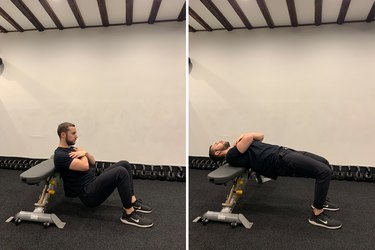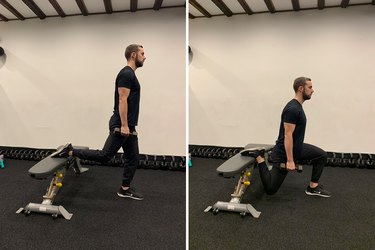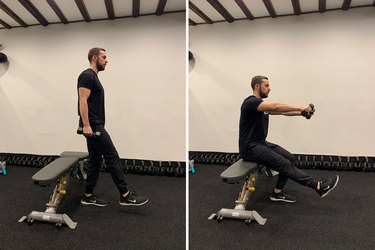
Fitness influencers across Instagram seem to promote body-weight squats as the exercise for glute growth. And while they're a necessary first step to developing proper form and fundamental strength, they probably won't be the only magic key to achieving the well-rounded butt of your dreams.
Glute gains are a science and require a strategic strength-training regimen. But if you add volume and variety to your lower-body training regimen — with some patience — you'll begin to seeing your desired results.
Video of the Day
Video of the Day
Join the LIVESTRONG.com 4-Week Butt Lift Challenge.
Body-Weight Squats Work — Only to a Point
Noticing a booty-building plateau (one of the worst kinds!) even though you've been adding more body-weight squats to your workout routine? It's actually a pretty common problem, and if you've mastered the body-weight squat, it's probably time to change things up.
No trainer will deny that squats are among the top exercises for building functional strength in your lower body (and yes, they do build your glutes). But over time, your body adapts to the exercises you do, so in order to keep experiencing hypertrophy (muscle growth), you need a new stimulus, according to the National Academy of Sports Medicine (NASM).
This is where the principle of progressive overload comes in. To keep the booty (and all muscles) growing, you need to consistently increase your training volume, according to NASM. That means either increasing weight, sets and/or reps.
"Training volume is the key variable in muscle building," says Henry Halse, CSCS. "Increasing weight will help you build muscle and strength, whereas increasing only sets/reps won't help you build as much strength."
If you're a beginner, body-weight squats are a great place to start, as they'll help you learn proper form and movement patterns and develop foundational strength. But after you've progressed past the beginner level, it's time to add some volume and throw a barbell (or kettlebell or dumbbell) on those squats.
Add Weight to Your Squats
Once you can comfortably perform 3 sets of 20 body-weight squats, it's time to progress to the next level by upping the resistance, Halse says.
Adding weight to your squats not only helps your glutes develop but it'll take some of the boredom out of a repetitive body-weight squat routine. The barbell back squat is one option.
Barbell Back Squat
- Place a barbell on a rack right below shoulder height and step underneath the bar, aligning it behind your neck and across the top of the back.
- Grip the bar with the hands wider than shoulder-width apart. Keep your chest up and shoulder blades back.
- Bring the bar off the rack, step backward and place your feet slightly wider than shoulder-width apart.
- Perform a squat, sitting into the hips, keeping the back straight and chest up.
- At the bottom of the squat, press into your heels and push your hips forward to return to standing.
If you're working with barbell squats for the first time, begin with just the bar. Or, if this feels challenging and you're not able to maintain good form, load your squats with a pair of dumbbells, held at your sides.
Once a back squat feels easy and comfortable with just the bar, add weight plates on either side. It can be intimidating to load your squats for the first time (especially if the barbell feels like a foreign object). Don't hesitate to ask a trainer at your gym to spot your form or team up with an experienced gym buddy!
Do These 3 Moves to Increase Glute Gains
Your glutes are the largest muscle in your body (your gluteus maximus, specifically), so you'll need to incorporate different exercises to activate each part of this muscle group (the gluteus medius and minimus are the other two muscles that make up your glutes). Halse recommends you complement your squats with these three moves:
1. Hip Thrust

- Sit in front of a bench or box with your mid-back against the edge. Plant your feet flat on the ground.
- Lean back against the bench and lift your hips up until your body forms a straight line from your shoulders to your knees.
- Then, lower your hips to the ground and repeat.
- Push through your heels, not your toes, when driving your hips up.
As you perform this exercise, pause momentarily at the top of the move and give your glutes an extra squeeze. Once you feel comfortable with this move, you can add a barbell over your hips to add some resistance to the exercise and build more muscle.
If you want to get even more burn from this exercise, lower the weight slowly for three counts, press through your heels and raise your hips for one count and pause at the top, holding the move isometrically for one count. See below for more on varying your reps.
2. Bulgarian Split Squats

- Stand in front of a bench or box at or below knee height. Face away from the bench/box.
- Lift one leg and place your foot on the object, curling your toes to help maintain balance.
- Keeping your back flat and shoulders back, lower your elevated knee until it touches the ground. Keep your front leg rooted and avoid letting your front knee trail beyond your toes.
- Once your back leg touches the ground (or nearly does), press through your front heel and press to standing.
Throughout this exercise, focus on keeping most of your weight on your front leg. As you grow comfortable with this exercise, you can either hold dumbbells at your sides or a barbell over your back.
3. Single-Leg Squats

- Hold a pair of light dumbbells and stand in front of a bench or box, facing away from the object.
- Raise one leg slightly off the ground and reach the dumbbells forward, holding them in front of your body.
- At the same time, lower your body toward the bench or box until you're seated, keeping a leg off the ground.
- Press through the heel of your rooted leg and push your hips forward to return to standing.
Vary Your Reps With These Methods
While barbell back squats are generally synonymous with booty gains, changing your rep range or style will help increase your training volume and can be a fun way to mix things up, Halse says.
AMRAP sets (as many reps as possible) are a popular way to add volume and variety. This involves performing as many reps as possible with proper form of a certain exercise
Burn out sets or drop sets are another option, Halse says. Perform an exercise with a specific amount of weight for a certain amount of reps. Then, drop the weight a certain amount (for instance, lower the weight by 50 percent) and repeat the exercise until you fatigue or "burn out" the muscle.
Drop sets are excellent for depleting your muscle's glycogen stores, which leads to acidosis, damaging your muscle fibers, according to the American Council on Exercise (ACE). It may sound scary, but acidosis is actually a good thing for muscle growth, as it encourages your body to repair the damaged fibers, growing larger and stronger muscle in its place.
Another way to play around with an exercise is to increase the time under tension, according to ACE. As in a drop set, increasing your muscle's time under tension (TUT) increases the amount of damage and growth in your muscle fibers.
Boosting your booty's TUT involves increasing the amount of time your glutes contract against resistance. So, if you're performing a squat, for instance, you can lower toward the ground at a slower pace (think 3 to 4 seconds) to increase the time your glutes are under tension. You can also pause at the bottom of the squat for a moment or two.
Trim Down on Cardio
Cardio is necessary for overall heart health and deserves a place in your fitness routine. But if you're looking to grow your glutes and find yourself doing cardio sessions most days each week, you may want to cut back.
You should aim to get 150 minutes of moderate cardio activity — or 75 minutes of vigorous intensity cardio — each week, according to the Centers for Disease Control and Prevention. But performing excessive cardio exercise may feed into your stored muscle glycogen, hindering your muscle growth and development, according to ACE.
There's a lot of debate around whether you should perform cardio before or after strength training. But if your goal is muscle gain, do your cardio after hitting the weights, as endurance exercise can decrease the efficacy of strength training, according to ACE.
Put simply: Devote a majority of your energy to strength training and use what you have left for moderate-intensity cardio.